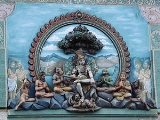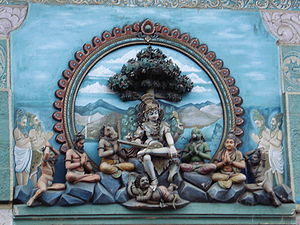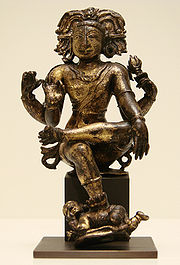
Dakshinamurthy
Encyclopedia

Tamil language
Tamil is a Dravidian language spoken predominantly by Tamil people of the Indian subcontinent. It has official status in the Indian state of Tamil Nadu and in the Indian union territory of Pondicherry. Tamil is also an official language of Sri Lanka and Singapore...
: தட்சிணாமூர்த்தி, Sanskrit: () is an aspect of Shiva as a guru
Guru
A guru is one who is regarded as having great knowledge, wisdom, and authority in a certain area, and who uses it to guide others . Other forms of manifestation of this principle can include parents, school teachers, non-human objects and even one's own intellectual discipline, if the...
(teacher) of all type of knowledge, particularly the jnana
Jnana
Jñāna or gñāna is a Sanskrit and Pali word that means knowledge. It has various nuances of meaning depending on the context. The idea of jnana centers around a cognitive event which is recognized when experienced...
. This aspect of Shiva
Shiva
Shiva is a major Hindu deity, and is the destroyer god or transformer among the Trimurti, the Hindu Trinity of the primary aspects of the divine. God Shiva is a yogi who has notice of everything that happens in the world and is the main aspect of life. Yet one with great power lives a life of a...
is his personification as the supreme or the ultimate awareness, understanding and knowledge. This form represents Shiva in his aspect as a teacher of yoga
Yoga
Yoga is a physical, mental, and spiritual discipline, originating in ancient India. The goal of yoga, or of the person practicing yoga, is the attainment of a state of perfect spiritual insight and tranquility while meditating on Supersoul...
, music, and wisdom, and giving exposition on the shastras. He is worshipped as the god of wisdom, complete and rewarding meditation.. This form of Shiva is popular in the Southern states of India especially Tamil Nadu
Tamil Nadu
Tamil Nadu is one of the 28 states of India. Its capital and largest city is Chennai. Tamil Nadu lies in the southernmost part of the Indian Peninsula and is bordered by the union territory of Pondicherry, and the states of Kerala, Karnataka, and Andhra Pradesh...
.
Meaning
Dakshinamurti literally means 'one who is facing south ' in SanskritSanskrit
Sanskrit , is a historical Indo-Aryan language and the primary liturgical language of Hinduism, Jainism and Buddhism.Buddhism: besides Pali, see Buddhist Hybrid Sanskrit Today, it is listed as one of the 22 scheduled languages of India and is an official language of the state of Uttarakhand...
. South is the direction of Death, hence change. In every Siva temple the stone image of Dakshinamurthy is installed, facing south, on the southern circumambulatory path around the sanctum sanctorum. Perhaps, of all Hindu Gods, he is the only one sitting facing south. The great seer Ramana Maharshi
Ramana Maharshi
Sri Ramana Maharshi , born Venkataraman Iyer, was a Hindu spiritual master . He was born to a Tamil-speaking Brahmin family in Tiruchuzhi, Tamil Nadu. After experiencing at age 16 what he later described as liberation , he left home for Arunachala, a mountain considered sacred by Hindus...
, has interpreted the name as "Dakshina-amurty", meaning one who is capable but without form.
Depiction

In his aspect as Jnana Dakshinamurti, Shiva is generally shown with four arms. He is depicted seated under a banyan tree, facing the south. Shiva is seated upon a deer-throne and surrounded by sages who are receiving his instruction. He is shown as seated with his right foot on mythical apasmara
Apasmara
According to Hindu mythology, Apasmara was a dwarf who represented ignorance and epilepsy. During the cosmic dance of tandava by god Shiva in the form of Nataraja - the Lord of Dance, Apasmara was crushed by the right foot of Shiva and was killed. This mythological dwarf is generally depicted with...
(a demon which, according to Hindu mythology
Hindu mythology
Hindu religious literature is the large body of traditional narratives related to Hinduism, notably as contained in Sanskrit literature, such as the Sanskrit epics and the Puranas. As such, it is a subset of Nepali and Indian culture...
, is the personification of ignorance) and his left foot lies folded on his lap. Sometimes even the wild animals, are depicted to surround Shiva. In his upper arms, he holds a snake or rosary or both in one hand and a flame in the other; while in his lower right hand is shown in vyakhyanamudra, his lower left hand holds a bundle of kusha grass or the scriptures. The index finger of His right hand is bent and touching the tip of his thumb. The other three fingers are stretched apart. This symbolic hand gesture or Mudra
Mudra
A mudrā is a symbolic or ritual gesture in Hinduism and Buddhism. While some mudrās involve the entire body, most are performed with the hands and fingers...
is the Gnana Mudra (or Jnana Mudra or Jana Mudra), a symbol of knowledge and wisdom. Sometimes, this hand is in the Abhaya Mudra, a posture of assurance and blessing.In Melakadambur
Melakadambur
Melakadambur is a village located from Chidambaram,and can reach at 6 km from Kattumannarkoil, Cuddalore district, Tamil Nadu, India. It is known for Arulmigu Amirthakateshwarar Thirukkoil, constructed during the reign of Cholas by Kulothunga Chola...
the dakshinamoorthy looks seated on a bull under a banyan tree,a hole in this statue's ear that extends to the next ear was an wonderfulsculturing.
Dakshinamurthy is portrayed as being in the yogic state of abstract meditation - and as a powerful form brimming with ever flowing bliss and supreme joy. Variations of this iconic representation include Veenadhara Dakshinamurthy (holding a Veena
Veena
Veena may refer to one of several Indian plucked instruments:With frets*Rudra veena, plucked string instrument used in Hindustani music*Saraswati veena, plucked string instrument used in Carnatic musicFretless...
), Rishabharooda Dakshinamurthy (mounted on a Rishabha - the bull) etc.
Maharshi Kardamshankara Jnanadeva, a mystic seer says that Dakshinamoorthy means the abstract or hidden power of the absolute which expressed in all enlightened masters.
Significance
Indian tradition accords a special reverence to the Guru or the teacher. Dakshinamurthy, in the Saivite system of beliefs is regarded as the ultimate Guru - the embodiment of knowledge and the destroyer of ignorance (as represented by the demon being crushed under the feet of the deity). The Jnana Mudra is interpreted in this way:- The thumb denotes the God and the index finger denotes the man. The other three fingers stand for the three congenital impurities of man viz. arrogance, illusion and bad deeds of the past births. When man detaches himself from these impurities, he reaches God. The Abhaya Mudra, a gesture with the hand lifted above thigh with palm facing out, fingers pointing, is interpreted as His grace upon His students. The rosary or the snake signifies Tantric knowledge. The fire represents illumination, removing the darkness of ignorance.Impact on Indian Life
The fifth day of the week, Thursday is associated with the planet Jupiter and is referred to as Guruvar (or Guruvaaram). Thursdays are considered auspicious to start any educational endeavours. It is on Thursdays that special worship services are offered to Dakshinamurthy in many Saivite temples. Some temple traditions hold full moon nights, particularly the night of the Guru Poornima as the appropriate time for worship services to Dakshinamurthy.Temples

Ardhanari
Ardhanarishvara , is a composite androgynous form of the Hindu god Shiva and his consort Parvati . Ardhanarishvara is depicted as half male and half female, split down the middle...
form. In Thirupulivanam, we can find Dakshinamurthy in the form of Ardhanariswara.
This temple is on the Uthiramerur-Kanchipuram road, 5 km from Uthiramerur, near Chennai.
http://prabhukrish.net/2006/03/13/uthiramerur/
In March 2007, a big temple of Lord Dakshinamurty (the first in Maharashtra) was created in the Shrutisagar Ashram, about 30 km from Pune
Pune
Pune , is the eighth largest metropolis in India, the second largest in the state of Maharashtra after Mumbai, and the largest city in the Western Ghats. Once the centre of power of the Maratha Empire, it is situated 560 metres above sea level on the Deccan plateau at the confluence of the Mula ...
.
Hymns
Dakshinamurthy Ashtakam by Adi ShankaraAdi Shankara
Adi Shankara Adi Shankara Adi Shankara (IAST: pronounced , (Sanskrit: , ) (788 CE - 820 CE), also known as ' and ' was an Indian philosopher from Kalady of present day Kerala who consolidated the doctrine of advaita vedānta...
charya is a laudatory hymn for this form of Siva.

